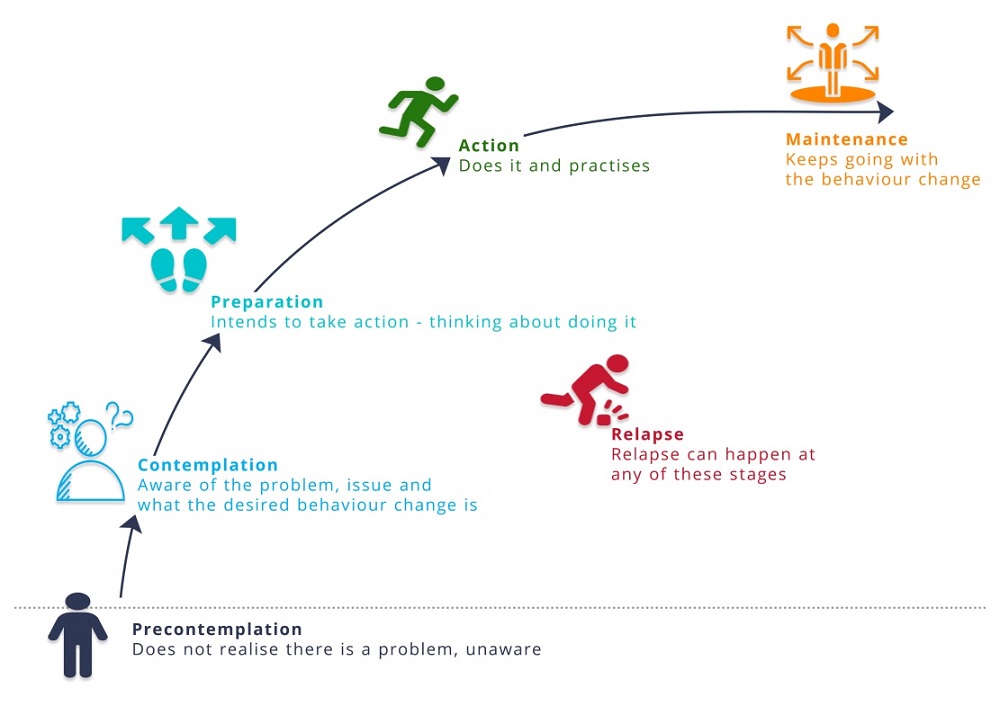Previously, I outlined how adopting a solution-focused mindset and using some of the techniques associated with Solution-Focused Brief Therapy (SFBT) can be a powerful approach to incorporate into your work as a coach. This blog highlights the importance of being mindful of nature of change itself.
When dealing with change, Solution-Focused work is a stickler for the first step. Solution-focused work argues that change occurs through a series of small, manageable steps and these small changes have the potential to lead to big changes. Notice how the miracle question asks about the immediate future, not the distant. Notice also how Solution-Focused work concentrates on finding exceptions. It presupposes that the seeds of change may already be present.
Solution-focused work relies on the basic assumption that clients must want to change. But change is hard. Hard to acknowledge. Hard to maintain. How many new year’s resolutions have you kept? How many diets you tried that you stuck at? Is there more to learn?

Motivational Interviewing & Solutions
Motivational Interviewing (MI) is a counselling approach developed by William R Miller and Stephen Rollnick which began in the 1980s, in order to help people with substance abuse disorders, particularly problem drinkers. In their experience with this client group in particular, William Miller and Stephen Rollnick discovered that whilst working in a solution-focused way had some merit, despite the best of intentions, it did not necessarily lead to sustained action and sometimes, quite frankly, it did not work at all.
This led to the idea that, perhaps the reason for this lay in reconceptualising the nature of change itself. Motivational Interviewing (MI) is similar to solution-focused work in that in order for change to happen there is a requirement to focus on goals that are small, important to the client and orientated in the future. Crucially though, MI Is also different to other techniques in that it does not necessarily assume a person wants to embrace or start the process of change.

MI incorporates the idea that every single patient may be in differing stages of readiness levels and therefore anyone in a helping capacity may need to act accordingly to the levels and current needs.
In a very solution-focused way of approaching the subject of change, William Miller and Stephen Rollnick studied thousands of people and looked at what they were doing in order to make transformational changes in their lives. Looking for some type of pattern.
The Stages of Change Model
One of the aspects of MI which is most well-known is the Trans-Theoretical Model or the Stages of Change Model, credited to James Prochaska and Carlo DiClemente. This has become one of the most researched and scientifically validated models used to help explain change. The model asserts that change has a number of distinct phases we each go through just before or when we experience change.
Precontemplation: Where there is no intention of changing behaviour. The person may be unaware that a problem exists.
Contemplation: The person becomes more aware that there is a problem, but has made no commitment to change. A substantial amount of time can be spent on this stage because many people may not find themselves ready to commit to making a change. They remain in this stage, perhaps feeling stuck as they go back and forth between measuring the bests and costs of behavioural change.
Preparation: The person is intent on taking action to correct the problem and begins to mobilise themselves
Action: The person actively begins to change their behaviour.
Maintenance: Sustained change occurs. New behaviour replaces old ones over time.
Relapse: The person falls back into old patterns of behaviour. Relapses can and do occur at any stage. The person then needs to reengage and loop back into this change process once more.

Crucially, James Prochaska and Carlo DiClemente argue that clients will not progress through these stages in a linear way. Individuals will move back and forth through the stages. This can include rapid and effective change periods, followed by almost inevitable relapses.
Take a look at the informative video by Nathan Smith about the Trans-Theortetical Model of Behaviour Change, which reiterates the different stages of change people go through by using a real-world example, in this case, wanting to exercise more.
Does this resonate with changes that you may have tried to introduce in your life? Be aware of the difficulties / barriers that can occur when moving through the stages. Sometimes it can take a while to move from one stage to another. At each stage, how the potential for relapse creeps in. In all aspects of change, people begin at their own starting point. This will be different for each person.
Change is hard. It often involves some regression and relapse. This is true in life. It is true too in the coaching context. The Stages of Change Model can be helpful in understanding difficulties you may encounter when helping a client to change. When this happens, take a moment to consider where your client might be in their stages of change. Would it be helpful to share this with your client? Can they themselves identify where they are on the change curve? It may, in turn, help you to determine how best you can further support your client and what else is needed to keep them resourcefully moving forward.
Perhaps you might be contemplating a change too?
Are you also ready for something different? If so, where are you in this change process? Perhaps some coaching might support you too? Why not, take your first step towards making that change and get in touch here.
About us
We are a team of highly experienced executive coaches, focused on developing leaders working in high-stakes environments across diverse sectors. We create space for leaders to step back, think clearly, and navigate complexity with confidence and renewed purpose. Our narrative-based approach blends deep listening, incisive questioning and rigorous thinking with a strong commercial focus.
“Our Knowledge Centre is designed to resource leadership practice and development. The articles we share on this site are intended to spark fresh thinking, offer practical tools, and support continuous professional growth.”
Jude Elliman
Founder
Our approach
We work with leaders to build their leadership brand and impact. Our approach includes:
✔ Challenge and support: creating time and space for rigorous thinking and problem-solving
✔ Narrative coaching: defining and refining the stories that shape leaders and organisations
✔ Commercial focus: cutting through complexity for strategies that inspire change and drive results
We help leaders make crucial decisions, align teams for greater effectiveness, and envision new possibilities for the future.
